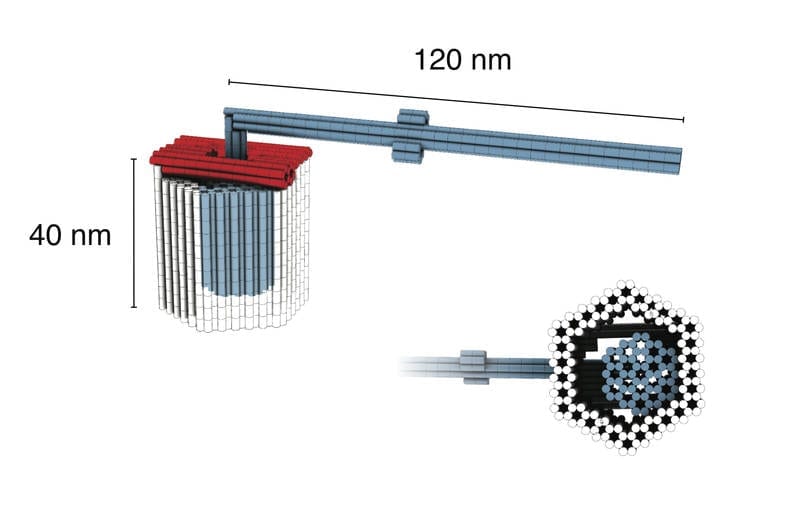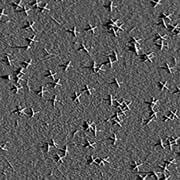
Dietz lab’s latest DNA nanomachines demonstrate dynamics and precision
Scientists at the Technical University of Munich (TUM) have built two new nanoscale machines with moving parts, using DNA as a programmable, self-assembling construction material. In the journal Science Advances, they describe a rotor mechanism formed from interlocking 3-D DNA components. Another recent paper, in Nature Nanotechnology, reported a hinged molecular manipulator, also made from DNA. These are just the latest steps in a campaign to transform so-called “DNA origami” into an industrially useful, commercially viable technology.
Inspired by nature’s nanomachines – such as the enzyme ATP synthase and the motor-driven flagella of bacteria – physicists in Prof. Hendrik Dietz‘s lab at TUM keep expanding their own design and construction repertoire. They have systematically developed rules and procedures for creating self-assembled DNA origami structures with ever greater flexibility and control. Moving from DNA basepair matching to shape-complementary building techniques – with a variety of interlocking “bricks” – the researchers’ toolkit has advanced steadily in the direction of higher-level programming and modular assembly.
In step with this progress, they have honed methods needed to verify, for example, that a particular soup of nanoparticles really is packed with copies of whatever they designed: whether a switchable gear, an artificial membrane channel, an arbitrarily complicated test object, a “nanobook” that opens and closes, or a robot figure with movable arms.
Two new additions to the zoo
The latest additions to the lab’s zoo of DNA origami objects, two tiny 3-D machines with moving parts, demonstrate new capabilities. (See video at EurekAlert, 1’23”.)
Doctoral candidates Philip Ketterer and Elena Willner collaborated with Dietz in building a rotory mechanism from three multilayer DNA building blocks: a rotor unit, with a body roughly 32 nanometers long and a longer, lever-like extension; and two clamp elements that “click” together to form an axle bearing. The parts join with a tight fit and leave just 2 nanometers of play around the axle, allowing the rotor to swing but not to wobble. In one variant, the arm will rotate freely between random stopping points; in another, it will dwell in specified positions the researchers call docking sites. To date, this is the most complex rotary structure realized using DNA origami techniques.
To be clear, the rotor has no motor: It is propelled by Brownian motion, random movement of particles in solution. By demonstrating the feasibility of building such a machine, however, the researchers open the way for active devices under chemical or thermal power and control. “It’s like having built an engine,” Dietz says. “Now spark plugs and combustible fuel are the next items on the to-do list.”
In a separate project, Dietz and doctoral candidate Jonas Funke created a hinged machine on a scale suitable for manipulating individual molecules with atomic precision. The angle between the gripper’s two main structural elements can be controlled with DNA helices. Experiments with this DNA origami positioning device showed that it could be capable of precisely placing molecules, adjusting the distance between them in steps as small as the radius of a hydrogen atom. This work is significant in that it bucks a trend in the field toward building larger DNA origami devices without necessarily pushing the limits of precision. In addition, the results hint at one of the ways DNA nanomachines might someday be useful to control chemical reactions.
“On the one hand,” Dietz says, “we now really trust the placement precision within our structures – because we have actually placed two molecules and controlled their distance with atomic precision. On the other hand we have now a prototype rotary mechanism. Based on our measurements, its mobility is such that it could do up to 50,000 rpm if every rotary step it took would go only in one direction. In the next generation of devices, we will use the placement precision to couple chemical reactions to the movements of a rotor. This has the potential to result in a motor.
This device, then, could be used for all kinds of purposes, such as actively propelling nanoscale drug-delivery vehicles, pumping and separating molecules across barriers, or packaging molecules into cargo compartments.”
Learn more: Nanoscale rotor and gripper push DNA origami to new limits
The Latest on: DNA origami
[google_news title=”” keyword=”DNA origami” num_posts=”10″ blurb_length=”0″ show_thumb=”left”]
via Google News
The Latest on: DNA origami
- Best DNA Test for 2024on May 3, 2024 at 4:01 am
CNET’s expert staff reviews and rates dozens of new products and services each month, building on more than a quarter century of expertise. Open up even more of your world with the best at-home ...
- Ancient DNA pulls back curtain on mysterious empireon April 27, 2024 at 8:00 am
Editor’s note: A version of this story appeared in CNN’s Wonder Theory science newsletter. To get it in your inbox, sign up for free here. Primarily known from the accounts of their Byzantine ...
- Research combines DNA origami and photolithography to move one step closer to molecular computerson April 24, 2024 at 8:49 am
Molecular computer components could represent a new IT revolution and help us create cheaper, faster, smaller, and more powerful computers. Yet researchers struggle to find ways to assemble them more ...
- Citizen Scientists Will Capture DNA From 800 Lakes In One Dayon April 19, 2024 at 12:18 am
DNA is coming off of every species where they live ... Lately, she’s been playing with origami circuits and trying to perfect a gluten-free sourdough recipe. John Dankosky works with the radio team to ...
- Capturing DNA origami folding with a new dynamic modelon April 17, 2024 at 5:00 pm
This field is called DNA nanotechnology, and its most popular implementation, DNA origami, lets researchers fold DNA into any shape, providing a powerful approach for building nanoscale devices ...
- Nathan Derron April 17, 2024 at 1:37 pm
Editor Keiko Hirose. Zanacchi FC, Manzo C, Alvarez AS, Derr ND, Parajo MG, Lakadamyali M. (2017) A DNA origami platform for quantifying protein copy number in super-resolution. Nature Methods. 8, ...
- Neuroscientists Discover Shapeshifting DNA Controls Memory Formationon April 17, 2024 at 9:16 am
Neuroscientists have uncovered a new mechanism for memory formation, and it involves changes in the structure of your DNA. If you were asked to picture a molecule of DNA, chances are you would ...
- Discovery of DNA repair mechanism advances understanding of how human cells stay healthyon April 16, 2024 at 5:01 pm
Researchers at the University of Toronto have discovered a DNA repair mechanism that advances understanding of how human cells stay healthy, and which could lead to new treatments for cancer and ...
- Study reveals how DNA gyrase resolves DNA entanglementson April 11, 2024 at 5:00 pm
The coiled telephone cord and the DNA double helix that stores the genetic material in every cell in the body have one thing in common; they both supercoil, or coil about themselves, and tangle in ...
via Bing News










